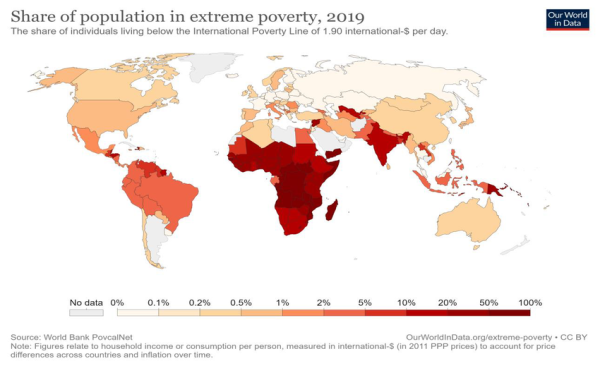
In an area of Russia, Ulyanovsk (you-la-nav-skah), there has been a national holiday on September 12th since 2006 called the National Day of Conception. Couples are given the day off work, and those who are able to have a child 9 months later, are then registered for prizes such as SUVs, video cameras, TVs, etc. This is in response to Russia’s 1.3 fertility rate in 2006. In 2022, the Russian fertility rate was 1.83. A 0.05% increase from 2021.

From this map from around 2017, we can see that most of the fertility rates in the world are below 2. Replacement theory is a theory that you need a fertility rate of 2.1 in order for the next generation to exactly replace the older generation, (which doesn’t factor in immigration). Many of the world’s countries are below the 2.1 rate needed, or are just barely above the rate. And by 2030, the global fertility rate is projected to be 1.75. But we can also see a big clump of extremely high fertility rates around Africa, and some in the Middle East. The question is, what are these countries doing that the other countries aren’t?

The answer sadly is, poverty. A low poverty rate allows for more people to not need to work to be able to eat, it allows for more downtime, and allows for more people to have control over their individual lives. Particularly women, who have started delaying or forgoing marriage due to these low poverty rates. They end up marrying later in life, and birth rates for single women are less than half of those who are married. Additionally, fertility rates among women aged 30 to 49 are rising due to them marrying later.
A low poverty rate also usually comes with women empowerment in education and the workforce, hence why they are marrying later. Low poverty also brings a lower child mortality rate, so we’re having less children since less children are dying. Low poverty also brings the increased cost of raising children, since affluent societies have things like child care and preschool that impoverished countries don’t.
However, a low poverty rate doesn’t mean everyone just doesn’t want children. Many people within affluent countries want to possibly have children, but choose not to due to lack of economic support. The difference between people in affluent countries and the people in impoverished countries, is that they get a choice. Many people, especially women, from impoverished countries do not get a choice whether to have children due to high concentrations of violent crime, lack of proper medical resources, and lack of access to contraceptives.

But how does this impact us? The number of people aged 65 or older grows at an average annual rate of 1.2 percent, which doesn’t sound like a lot, but it’s faster than the annual rate for people ages 15 to 54. People aged 65 or more today comprise the world’s fastest growing age group. In 2018, globally, for the first time, older persons outnumbered children under the age of five, and by 2050, older persons will outnumber people aged 15 to 24.
Population growth is generally projected to slow between 2023 and 2053, averaging 0.3 percent per year over that period. This rate, coupled with an increase in life expectancies, is creating an aging population, which puts pressure on healthcare systems globally. Because the population size of 65 year-olds or more is so large, federal programs such as Social Security and Medicare have an increase of dependents.
The size of the population ages 25 to 54 affects the number of people employed, the workforce will shrink which leads to less positions being filled and a stalling economy. And less taxes being paid. At the same time as our older population is ballooning, the population we need to support them is shrinking.
This slow economic growth and less taxes causes a strain on government budgets. Young people within the workforce sustain the economy by funding pensions when people retire. As well as paying the taxes that finance Social Security, Medicare, and many other government programs. And buying the homes and stocks people invest in. Many school districts are also experiencing drops in enrollment, as seen in the Shoreline School District.

At the end of the day, the real question is whether this is a problem we should be worried about? Should we sound the alarm bells and force all our women to wear color coded outfits and outlaw them from reading? Surprisingly, it depends on who you ask. There is a continuing narrative popping up, usually coupled with pro-life arguments and anti-contraceptive propaganda, that our fertility rates going down are a big and world-ending issue.
But actually, regions such as Central, South, and Southeast Asia, Latin America and the Carribbean’s populations are projected to continue to grow, and reach their peak sizes before 2100. In sub-Saharan Africa, the total population is projected to double by 2050, the population of working-age people is growing faster than any other age group in that region.
The only region that is actually expected to experience an overall population decrease between 2022 to 2050 is Europe, with a predicted decline of 7%. And Japan, where the fertility rate has declined dramatically, still benefits from a growing global labor force and a growing global marketplace. How?
Immigration is predicted to become the sole driver of population growth in high-income countries. Many of the states within the US that have the largest decline in fertility rates, still have a strong overall population growth because of immigration. Immigration helps fill in the holes in the workforce due to a shrinking native population. By making it easier for immigrants to gain citizenship, more revenue is generated for the government, thus lessening the expected budget declines with the shrinking native population.
In the U.S. and many other nations, women are less likely than men to be employed. Our government could also pass policies that make it easier for adults to work and raise children, policies that support mothers in the workplace, and policies that ensure that all children have access to a good education. Such as paid parental leave, expanding access to high-quality child care, early-childhood education, and higher education. We can encourage people to have more children by enacting policies that make parenting more attainable.
To help with the ballooning of the elderly population, we also would need to invest in education, affordable health-care, and social protection services to provide a public safety net for those elderly people.
But what happens if fertility rates continue to decline and our government does nothing about it? We don’t know, but many of the people who are concerned about lowering fertility rates claim it’ll be a disaster. Some even believe it will lead to the extinction of the human race.
Experts point out a less severe conclusion, it’s not the end. Ultimately, it means there will be less people. It’s not a good thing nor is it a bad thing, but it’s important to look at how we got here rather than that we’re here.
Our fertility rates are going down because women get more choice, contraceptives are more widely available, and people are getting the right to choose whether or not to bring children into this world. In probably the first time in centuries, women and men are not pressured into having children on a societal level. Now, we have a choice.
Sources:
- https://www.cia.gov/the-world-factbook/field/total-fertility-rate/country-comparison/
- https://www.pewtrusts.org/en/research-and-analysis/issue-briefs/2022/12/the-long-term-decline-in-fertility-and-what-it-means-for-state-budgets
- https://www.un.org/en/un75/shifting-demographics
- https://www.cbo.gov/publication/58912
- https://www.unfpa.org/swp2023/too-few#:~:text=Despite%20fears%20that%20soon%20there,and%20correlate%20with%20rising%20lifespans.\
- https://fivethirtyeight.com/features/how-low-can-americas-birth-rate-go-before-its-a-problem/
- https://www.weforum.org/agenda/2022/06/global-decline-of-fertility-rates-visualised/
- https://data.worldbank.org/indicator/SP.DYN.TFRT.IN?locations=RU









